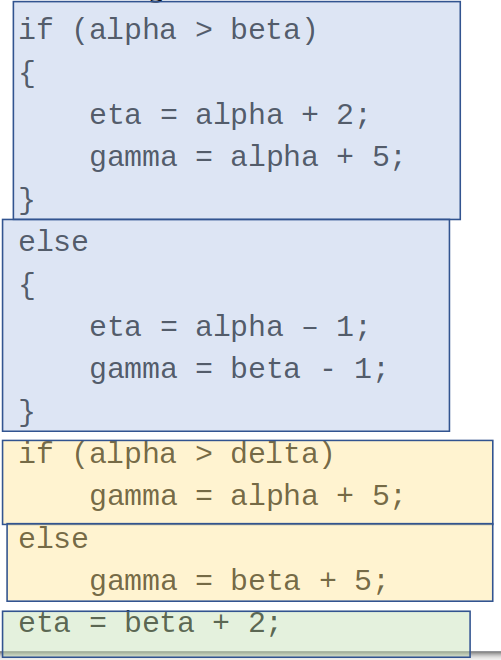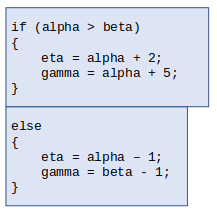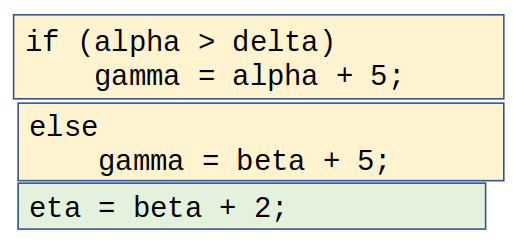Section 5.7 Worked Example: Sequential If-Else Statements
Subgoals for Evaluating Selection Statements.
- Diagram which statements go together
- For if statement, determine whether expression is true or false
- If true – follow true branch, if false – follow else branch or do nothing if no else branch
Subsection 5.7.1
You can watch this video or read through the content below it.
Given the following declarations:
int alpha = 2;
int beta = 1;
int delta = 3;
int eta = 0;
int gamma = 0;
Evaluate these statements and determine the value of all variables used.
if (alpha > beta)
{
eta = alpha + 2;
gamma = alpha + 5;
}
else
{
eta = alpha - 1;
gamma = beta - 1;
}
if (alpha > delta)
gamma = alpha + 5;
else
gamma = beta + 5;
eta = beta + 2;
Subsection 5.7.2 SG1: Diagram which statements go together.
Take note of the three parts of the sequence.
The first if-else (with the curly braces) is highlighted in blue in the figure below.
The second if-else (with no curly braces) is highlighted in yellow.
The final single statement is highlighted in green, and it is not part of the sequential if-else statements, so it will always be executed.

Subsection 5.7.3 SG2: For if statement, determine whether true or false
Because there are 2 sequential if-statements, we start with the first one, and then repeat SG2 and SG3 for the other.
First we evaluate (alpha > beta):
(2 > 1) is TRUESubsection 5.7.4 SG3: If true, follow true branch. If false, follow else branch (OR do nothing if there is no else branch).
eta = alpha + 2 = 2 + 2 = 4
gamma = alpha + 5 = 2 + 5 = 7

Subsection 5.7.5 SG2: For if statement, determine whether true or false
Because there are 2 sequential if-statements, we need to repeat SG2 and SG3 for the second if-statement in the sequence.
First we evaluate (alpha > delta):
(2 > 3) is FALSESubsection 5.7.6 SG3: If true, follow true branch. If false, follow else branch (OR do nothing if there is no else branch).
The condition is FALSE so we follow the else branch.
gamma = beta + 5 = 1 + 5 = 6
Next sequential statement is always executed:
eta = beta + 2 = 1 + 2 = 3

Answer.
alpha = 2, beta = 1, delta = 3, eta = 3, gamma = 6Practice Pages.
You have attempted of activities on this page.
